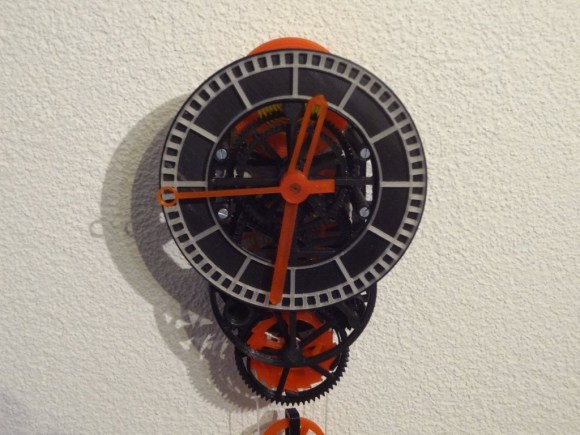
Many have tried, but [Christoph Laimer] has succeeded in designing a working, (relatively) accurate clock nearly completely from 3D printed parts. Every gear, pulley, wheel and hand of [Christoph’s] clock is printed. Only a few screws, axles, a weight, and a string are non-printed. Even the crank to wind the clock is a 3D printed part.
[Christoph] designed his clock in Blender. It took quite a bit of design work to create parts that would work and be printable. Even more work was involved in printing over 100 failed prototype parts.
One might think that [Christoph] is using the latest printers from the likes of Makerbot or Utimaker to achieve this feat. It turns out he’s using a discontinued Rapman 3.2 printer. Further proof that even “older” printers are capable of great things! [Christoph] does run his printer rather slowly. Printing a single gear with 0.125 mm layers and a 0.4 mm nozzle takes him 2 or 3 hours.
Mechanically, the clock is gravity powered with an anchor escapement. Rather than a pendulum, [Christoph] chose to use a balance wheel and hairspring assembly to govern the escapement. Even the spring is printed from standard PLA. The weight is suspended from a pulley block. The clock isn’t particularly efficient. 70cm of height will run the clock for only 2 hours.
[Christoph’s] clock has proven to be accurate to within 1/4 second per hour. He hasn’t provided temperature stability data – but being PLA, we’d suggest not getting it too hot!
Thanks [Jotham] and [Kyence]!














Amazing design, love it.
It’s a miracle he was able to print all that on a Rapman 3.2. It must be a heavily modded printer though.
I consider it nothing compared to being able to design that in Blender, I couldn’t even manage one cog without a proper 3D CAD package.
Not knowing 3D printing, I can’t comment. However the Antikythera Computer and a paper clock prove the basics are that. Given enough resolution…
That is a work of art. Well done!
So I’m trying to figure out if I could rig up some type of Bowden cable to a backpack. This way I could have a 3D printed wristwatch with the weights hanging off of my back.
Grab some paper, do some thinking, make a few sketches. Do some googling. Good luck! :)
aoeuidhtns- I love you!!!! From ;qjkxbmwvz
To Christoph: I have done about 30 failed gearsets already, and I’m more than deeply impressed with what you’ve got. Certainly you don’t need to hear other people complimenting your work, because I understand clearly: YOU ARE ALREADY MAX PROUD BECAUSE YOU DID IT!!!! It’s awesome. Can I help you figure out how to eliminate the weight by using a coil of un-extruded filament, and then figure out how to eliminate the other metal parts?
It’s beautiful. It’s the first real clock I’ve seen from filament. Others used borrowed or milled or lasered movements — yours is the real deal. Damn!
It’s just so easy to type your name!
Hah, and most people won’t get why. :) I’m glad to see there are other DVORAK users out there.
Now onto the subject of the clock. I must say, that’s very impressive. And since I know nothing about clock making, how do you get it to tick in accurate time? Does it have to do with the size or weight of the “torus” (for lack of a better word) around the spring?
Draws nigh?
I would’ve said it’s at hand, myself :P
Hmm, 0.7 metres, two hours. That means it has to be 8.4 metres off the floor if you want to wind it once a day. :eek: It’s a chimney clock or maybe a balcony clock if you trust the person under you not to play with your dangly bits.
I need to add. That is one of the best you tube explanatory you tube videos I have ever seen.
One way to make it run longer would be to use a pulley system so that you can increase the weight and effective string length while not increasing the load on the main bearings. If you get what I mean. But. Then one would need at least 7.2kgs of weight and 1.4 meters to keep it going for 24hours.
wow, that box of failed prints at the end of the video, that’s some devotion to make something work!
I’m in the process of printing this, starting long before it made HaD. It’s not easy, and there are lots of parts. So many friggen parts.
As a long-time maker of metal clocks, I applaud your perseverance and admire your excellent result.
Two things (intended to be helpful):
(1) make the axles different lengths. That way, assembling the frames is a little easier. With plastic plates, the bearings for each axle can be made different lengths too, unlike on a metal clock where the plates are flat. You could also use sub-plates, as often used in watches, and sometimes in clocks. Clocks tend to use cocks bolted to the plates, for some parts like the escapement wheel axle, which might need to be mounted separately. That makes them easier to assemble onto the plates. Plates need to be strong, especially if the clock uses a heavy weight.
(2) The ‘gold standard’ for accuracy in a clock is 1 second deviation in 100 days continuous running. Domestic clocks are less accurate, of course, and although yours is not terribly accurate, the accuracy you have achieved is good considering the way the clock has been made. Friction is the big problem in a clock, and I think any 3D printed gears will have too much friction because of the rough surface created by the edges of the layers. Friction in the escapement is a problem too, and the edges of the layers will cause trouble there too.
This is a very interesting project, so thanks for sharing some excellent development work.